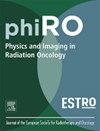以知识为基础的儿童颅脊髓照射模型的关键评估
IF 3.4
Q2 ONCOLOGY
引用次数: 0
摘要
背景与目的knowledge - based Planning (KBP)越来越多地用于规范和优化放疗计划。本研究旨在发展、完善和比较儿科患者颅脊髓照射(CSI)的多中心KBP模型。材料和方法共收集了来自意大利三个中心的113例CSI治疗,包括计算机断层扫描,靶标和器官轮廓以及治疗计划。治疗技术包括螺旋断层治疗(HT)和体积调节电弧治疗(VMAT)。建立了三种KBP模型:基于87例患者数据的完整模型(f模型),基于同一样本子集的简化模型(r模型),以及使用KBP重新优化方案的重新规划模型(rp模型)。采用拟合优度和预测优度指标评价模型的质量,并通过剂量-体积直方图(DVH)比较、预测偏差和方差分析对26例患者的验证集进行评估。结果f -模型和r -模型表现出相似的质量和预测能力,反映了原始数据集的可变性,并且在低至中剂量范围内具有较宽的预测区间。rp模型达到了最高的质量,预测范围更窄。rp模型更适合于跨中心的标准化规划,而f模型更适合于质量保证,因为它捕获了临床可变性。结论skbp模型可以有效预测DVHs,尽管几何变异性较大。然而,在高度可变的数据集上训练的模型无法同时达到高精度和准确度。比较KBP模型对于建立基准以满足特定的临床目标至关重要,特别是对于复杂的儿科CSI治疗。本文章由计算机程序翻译,如有差异,请以英文原文为准。
Critical assessment of knowledge-based models for craniospinal irradiation of paediatric patients
Background and purpose
Knowledge-Based Planning (KBP) is increasingly used to standardize and optimize radiotherapy planning. This study aims to develop, refine, and compare multicentric KBP models for craniospinal irradiation (CSI) in pediatric patients.
Materials and methods
A total of 113 CSI treatments from three Italian centers were collected, comprising Computed Tomography scans, target and organ contours, and treatment plans. Treatment techniques included Helical Tomotherapy (HT) and Volumetric Modulated Arc Therapy (VMAT). Three KBP models were developed: a full model (F-model) using data from 87 patients, a reduced model (R-model) based on a subset of the same sample, and a replanned model (RP-model) using KBP re-optimized plans. Models’ quality was evaluated using goodness-of-fit and goodness-of-prediction metrics, and their performance was assessed on a validation set of 26 patients through dose-volume histogram (DVH) comparisons, prediction bias, and variance analysis.
Results
The F-model and R-model exhibited similar quality and predictive ability, reflecting the variability of the original dataset and resulting in broad prediction intervals in low to mid-dose ranges. The RP-model achieved the highest quality, with narrower prediction bands. The RP-model is preferable for standardizing planning across centers, while the F-model is better suited for quality assurance as it captures clinical variability.
Conclusions
KBP models can effectively predict DVHs despite extreme geometric variability. However, models trained on highly variable datasets cannot simultaneously achieve high precision and accuracy. Comparing KBP models is essential for establishing benchmarks to meet specific clinical goals, particularly for complex pediatric CSI treatments.
求助全文
通过发布文献求助,成功后即可免费获取论文全文。
去求助
来源期刊

Physics and Imaging in Radiation Oncology
Physics and Astronomy-Radiation
CiteScore
5.30
自引率
18.90%
发文量
93
审稿时长
6 weeks
 求助内容:
求助内容: 应助结果提醒方式:
应助结果提醒方式:


